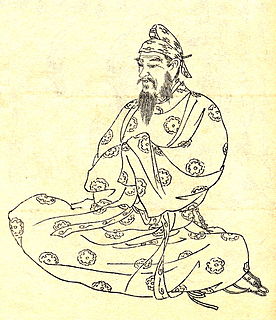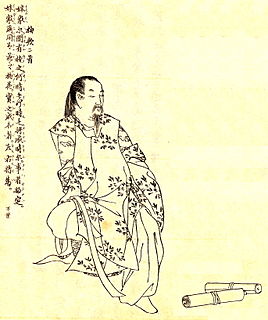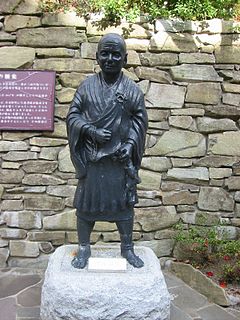 W
WAbe no Nakamaro , whose Chinese name was Chao Heng, was a Japanese scholar and waka poet of the Nara period. He served on a Japanese envoy to Tang-dynasty China and served as the Tang jiedushi (governor) of Annam.
 W
WAgatainukai (no) Michiyo , or Tachibana no Michiyo , is a court lady of early Nara period and mother of Empress Kōmyō.
 W
WAterui was the most prominent chief of the Isawa (胆沢) band of Emishi in northern Japan. The Emishi were an indigenous people of North Japan, who were considered hirsute barbarians by the Yamato Japanese.
 W
WAwata no Mahito was a Japanese nobleman of the late Asuka period and early Nara period.
 W
WEmpress Kōmyō (光明皇后) (701–760) was the Nara period consort of Japanese Emperor Shōmu (701–756).
 W
WEnnin , better known in Japan by his posthumous name, Jikaku Daishi (慈覺大師), was a priest of the Tendai school of Buddhism in Japan, and its third Zasu . Ennin was instrumental in expanding the Tendai Order's influence, and bringing back crucial training and resources from China particularly esoteric Buddhist training, and Pure Land teachings.
 W
WFujiwara no Fuhito was a powerful member of the imperial court of Japan during the Asuka and Nara periods. Second son of Fujiwara no Kamatari, he had sons by two women, and those sons were the founders of the four principal lineages of the Fujiwara clan: the South, North, Ceremonial, and Capital lineages. Also, he had four daughters by two other women, three by Kamohime, one by Tachibana no Michiyo. One daughter by Kamohime became Emperor Monmu's wife Miyako, who in turn gave birth to Emperor Shōmu. The daughter by Michiyo became the empress of his grandson Shōmu, Empress Kōmyō.
 W
WFujiwara no Kiyokawa , also known by the Chinese-style name Heqing (河清), was a Japanese noble of the Nara period. He was the fourth son of the sangi Fujiwara no Fusasaki, the founder of the Fujiwara Hokke. He reached the court rank of ju san-mi (従三位) and the position of sangi, and was posthumously awarded the rank of ju ichi-i (従一位).
 W
WFujiwara no Korekimi was a Japanese noble and statesman of the Nara period. He was originally known as Kuromaro (黒麻呂). He reached the court rank of ju ni-i (従二位) and the position of udaijin, and was posthumously promoted to ju ichi-i (従一位). He was also called Ushiya-daijin (牛屋大臣).
 W
WFujiwara no Kurajimaro was a Japanese statesman, courtier and politician during the Nara period.
 W
WFujiwara no Matate was a Japanese noble of the Nara period. He was the third son of the founder of the Hokke branch of the Fujiwara, the sangi Fujiwara no Fusasaki. He achieved the court rank of shō san-mi (正三位) and the position of dainagon, and posthumously of daijō-daijin. His original name was Yatsuka (八束).
 W
WFujiwara no Momokawa was a Japanese statesman, courtier and politician during the Nara period. His original name was Odamaro (雄田麻呂).
 W
WFujiwara no Muchimaro was a Japanese courtier (kuge) and politician of the early-Nara period.
 W
WFujiwara no Nagate was a Japanese noble of the Nara period. He was the second son of the founder of the Hokke branch of the Fujiwara, the sangi Fujiwara no Fusasaki. He achieved the court rank of shō ichi-i (正一位) and the position of sadaijin, and posthumously of daijō-daijin. He was also known as Nagaoka-Daijin (長岡大臣).
 W
WFujiwara no Umakai was a Japanese statesman, courtier, general and politician during the Nara period. The third son of Fujiwara no Fuhito, he founded the Shikike ("Ceremonials") branch of the Fujiwara clan.
 W
WFujiwara no Uona was a member of the Fujiwara clan in Japan and occupied the position of sadaijin "Minister of the Left" in the ancient Japanese court. He was the fifth son of Fujiwara no Fusasaki (681–737).
 W
WGenbō was a Japanese scholar-monk and bureaucrat of the Imperial Court at Nara. He is best known as a leader of the Hossō sect of Buddhism and as the adversary of Fujiwara no Hirotsugu.
 W
WEmpress Genmei , also known as Empress Genmyō, was the 43rd monarch of Japan, according to the traditional order of succession.
 W
WGyōki was a Japanese Buddhist priest of the Nara period, born in Ōtori county, Kawachi Province, the son of Koshi no Saichi. According to one theory, he was of Korean descent.
 W
WIsonokami no Yakatsugu was a Japanese noble and scholar of the late Nara period. He was the grandson of the sadaijin Isonokami no Maro and son of the chūnagon Isonokami no Otomaro. Yakatsugu himself reached the court rank of shō san-mi (正三位) and the position of dainagon, and was posthumously awarded the rank of shō ni-i (正二位).
 W
WEmperor Kammu was the 50th emperor of Japan, according to the traditional order of succession. Kammu reigned from 781 to 806, and it was during his reign that Japanese imperial power reached its peak.
 W
WKibi no Asomi Makibi was a Japanese scholar and noble during the Nara period. Also known as Kibi Daijin.
 W
WEmpress Kōken , also known as Empress Shōtoku , was the 46th and the 48th monarch of Japan, according to the traditional order of succession.
 W
WNagaya was a politician of the Nara period and an imperial prince of Japan, a son of Prince Takechi.
 W
WŌ no Yasumaro was a Japanese nobleman, bureaucrat, and chronicler. He may have been the son of Ō no Honji , a participant in the Jinshin War of 672.
 W
WŌmi no Mifune was a Japanese scholar and writer of kanshi and kanbun, who lived in the Nara period of Japanese history.
 W
WŌnakatomi no Kiyomaro was a Japanese noble of the Nara period. Born the seventh son of the chūnagon Nakatomi no Omimaro of the Nakatomi clan, he changed his name and founded the Ōnakatomi clan. He reached the court rank of shō ni-i (正二位) and the position of udaijin.
 W
WEmperor Shōmu was the 45th emperor of Japan, according to the traditional order of succession.
 W
WTachibana no Moroe was a Japanese Imperial prince and official in the court of Emperor Shōmu and Empress Kōken.
 W
WWake no Kiyomaro was a high-ranking Japanese official during the Nara period. He was born in Bizen Province to a family of politically important, devoted Buddhists who hoped to keep Buddhism and politics separate through religious reform. He became a trusted advisor to Emperor Kanmu, a position which he used to encourage the development of Buddhism in a direction which would prevent it from posing a threat to the government. According to the Shoku Nihongi, he was sent to the Usa Shrine to receive a divine message; stating that only those of descent from Amaterasu could become emperor, it refuted the previous divine message claiming Dōkyō was to be the next emperor after Empress Kōken. This report angered Dōkyō, who used his influence with the Empress to have an edict issued sending Kiyomaro into exile; he also had the sinews of Kiyomaro's legs cut, and only the protection of the Fujiwara clan saved him from being killed outright.